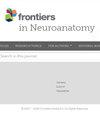小鼠背腹侧 CA 锥体神经元海马体外投射的解剖拓扑结构
IF 2.3
4区 医学
Q1 ANATOMY & MORPHOLOGY
引用次数: 0
摘要
海马主要通过由齿状颗粒细胞和 CA1-CA3 锥体神经元(PNs)组成的典型三突触回路发挥功能。其中,CA锥体神经元已知可投射到海马以外的各种边缘区域,对认知和情感行为产生重要影响。尽管有越来越多的证据表明这些海马体外投射,但具体的拓扑模式,尤其是 CA PN 类型之间及其背腹亚群之间的差异,仍有待全面阐明。在本研究中,我们利用细胞特异性 Cre 小鼠,注射了表达荧光蛋白的 AAV,对每种 CA PN 类型进行了标记。这种方法还能分别使用 EGFP 和 tdTomato 对背侧亚群和腹侧亚群进行双重荧光标记,从而对动物体内的轴突投射进行全面比较。我们的研究结果表明,CA1 PNs主要形成单侧投射到额叶皮层(PFC)、杏仁核(Amy)、伏隔核(NAc)和外侧隔(LS),而不像CA2和CA3 PNs只形成对LS的双侧神经支配。此外,根据 CA PN 的类型及其沿海马背腹轴的位置,尤其是 LS 亚区内的神经支配模式也有所不同。这种详细的地形图为 CA PN 类型之间的潜在功能区别提供了神经解剖学基础。本文章由计算机程序翻译,如有差异,请以英文原文为准。
Anatomical topology of extrahippocampal projections from dorsoventral CA pyramidal neurons in mice
The hippocampus primarily functions through a canonical trisynaptic circuit, comprised of dentate granule cells and CA1-CA3 pyramidal neurons (PNs), which exhibit significant heterogeneity along the dorsoventral axis. Among these, CA PNs are known to project beyond the hippocampus into various limbic areas, critically influencing cognitive and affective behaviors. Despite accumulating evidence of these extrahippocampal projections, the specific topological patterns—particularly variations among CA PN types and between their dorsal and ventral subpopulations within each type—remain to be fully elucidated. In this study, we utilized cell type-specific Cre mice injected with fluorescent protein-expressing AAVs to label each CA PN type distinctly. This method further enabled the dual-fluorescence labeling of dorsal and ventral subpopulations using EGFP and tdTomato, respectively, allowing a comprehensive comparison of their axonal projections in an animal. Our findings demonstrate that CA1 PNs predominantly form unilateral projections to the frontal cortex (PFC), amygdala (Amy), nucleus accumbens (NAc), and lateral septum (LS), unlike CA2 and CA3 PNs making bilateral innervation to the LS only. Moreover, the innervation patterns especially within LS subfields differ according to the CA PN type and their location along the dorsoventral axis of the hippocampus. This detailed topographical mapping provides the neuroanatomical basis of the underlying functional distinctions among CA PN types.
求助全文
通过发布文献求助,成功后即可免费获取论文全文。
去求助
来源期刊

Frontiers in Neuroanatomy
ANATOMY & MORPHOLOGY-NEUROSCIENCES
CiteScore
4.70
自引率
3.40%
发文量
122
审稿时长
>12 weeks
期刊介绍:
Frontiers in Neuroanatomy publishes rigorously peer-reviewed research revealing important aspects of the anatomical organization of all nervous systems across all species. Specialty Chief Editor Javier DeFelipe at the Cajal Institute (CSIC) is supported by an outstanding Editorial Board of international experts. This multidisciplinary open-access journal is at the forefront of disseminating and communicating scientific knowledge and impactful discoveries to researchers, academics, clinicians and the public worldwide.
 求助内容:
求助内容: 应助结果提醒方式:
应助结果提醒方式:


